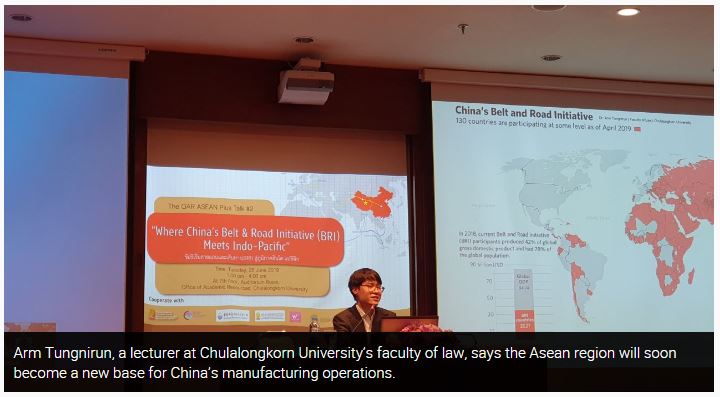Supply chains re-routed to Asean
CHINESE investment in the region’s manufacturing sector will intensify in the upcoming decade as China uses its Belt and Road Initiative (BRI) to reorientate the global supply chain towards Asean in response to its trade battle with the United States, a geopolitical expert predicts.
“The Asean region will soon become a new base for China’s manufacturing hub as China seeks to reorient the Asia Pacific’s supply chain,” said Arm Tungnirun, a lecturer at Chulalongkorn Unversity’s faculty of law and author of the book China 5.0.
Arm was speaking yesterday at an event titled “’Where China’s Belt and Road Initiative meets Indo-Pacific”, which was organised by the Office of Academic Resources and the Asean Studies Centre of Chulalongkorn University.
As the US-China trade conflict drags on, he said, its most significant impact has been the realignment of the global supply chain towards the Asean region. This is particularly so for foreign companies based in China and Chinese companies looking to invest abroad. The BRI has so far focused on infrastructure construction in developing countries throughout the world. This creates a fruitful business environment for Chinese firms that are looking to invest abroad, Arm said during an interview at the event.
With Chinese firms being hurt by the US tariffs and sanctions, the next phase of the BRI will be focused on realigning the manufacturing supply chain from China towards the Asean region, Arm said.
From 2013 to 2018, US$737 billion of BRI-related capital flowed into the Asean region, according to research by the CIMB Asean Research Institute (CARI) titled “China’s Belt and Road Initiative and Southeast Asia”.
Of these Asean countries, Indonesia gained the largest BRI-related capital flows at US$171 billion, followed by Vietnam with $152 billion, Cambodia $104 billion, Malaysia $98 billion and Singapore $70 billion. Behind them are Laos with $47 billion, Brunei $35 billion, Myanmar $27 billion, Thailand $24 billion and the Philippines $9 billion.
The key BRI-related projects in the region include phase one of the Bangkok-Nakhon Ratchasima railway, which was initiated in 2017 with an expected completion in 2021. The project is worth up to Bt179 billion.
Other projects include the Vientiane-Boten railway linking Laos with China at a cost of $5.8 billion, the $1.9 billion Cambodian Phnom Penh-Sihanoukville expressway, and the Morowali industrial park in Indonesia valued at $1.6 billion, according to the research.
The pace of the BRI projects and investment into the Asean region will accelerate even more due to the trade war, presenting the region with an unprecedented opportunity for economic growth, Arm claimed.
The Asean Development Bank (ADB) estimates that the total infrastructure investment needs in Asean from 2016 to 2030 will be between $2.8 trillion (the baseline estimate) and $3.1 trillion (a climate-adjusted estimate).
However, concerns were voiced by observers at the seminar about the risks of the BRI becoming a debt trap for developing countries.
The 414km Laos railway project linking Vientiane to Boten (on the Chinese border), for instance, has exacerbated Laos’ already precarious debt levels, which reached 68 per cent of GDP in 2016.
To optimise the benefits of the BRI and supply chain realignment in the region as well as minimise the debt risk of these Chinese-backed projects, Arm advised Asean governments to establish a common position on the BRI and cooperate as a region to assess the risks of the different BRI projects on a case-by-case basis.
Source: http://www.nationmultimedia.com/detail/Economy/30371749


 Thailand
Thailand




